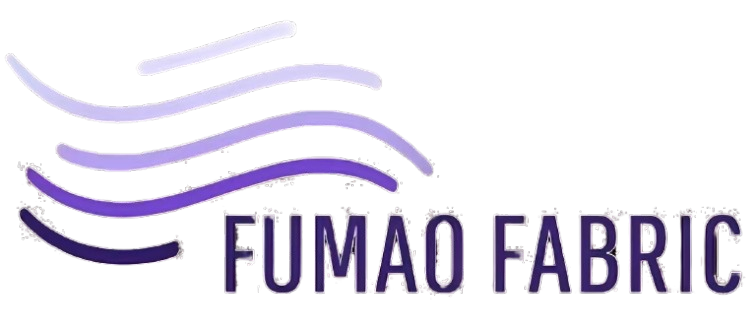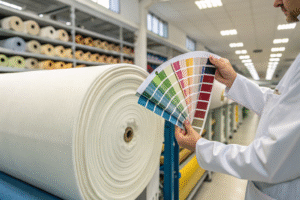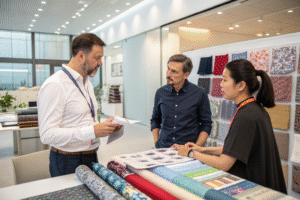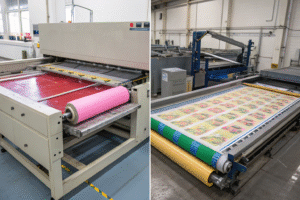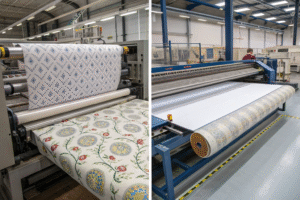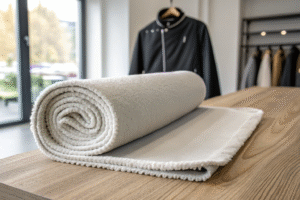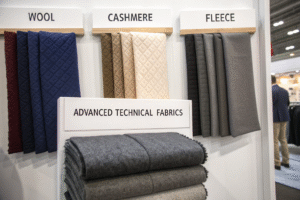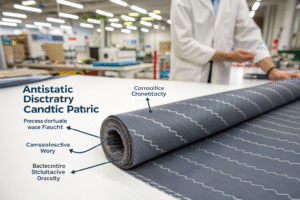In today’s eco-conscious fashion industry, sourcing isn’t just about price or softness—it’s about impact. More eco brands, especially those in the U.S. and Europe, now demand fabrics backed by climate-neutral certifications to ensure their supply chains reduce or offset carbon emissions. If you’re a buyer, designer, or brand owner aiming for sustainability, the next logical question is: how do I source climate-neutral certified fabrics from reliable suppliers?
Climate-neutral certified fabrics are verified to have net-zero carbon emissions, either through reduction or offset programs. Sourcing such materials helps eco brands align with sustainability goals, comply with regulatory expectations, and win environmentally conscious consumers. These fabrics may cost slightly more, but the long-term branding, compliance, and carbon savings make them essential for the next generation of responsible fashion.
Let’s break down how to identify, evaluate, and import climate-neutral certified fabrics in 2025.
What Does “Climate-Neutral Certified” Mean for Fabrics?
“Climate-neutral” means that the total carbon footprint of producing a fabric—measured from raw material to delivery—has been fully offset or minimized through verified reductions and carbon credits.
Fabrics with climate-neutral certification meet strict lifecycle carbon accounting standards, including verified emissions reports and offset programs audited by global certifiers.

Who Certifies Climate-Neutral Fabrics?
The leading organizations include:
- Climate Neutral: Requires brands to measure, reduce, and offset carbon emissions annually.
- Carbon Trust: Offers product carbon footprint labeling and reduction roadmaps.
- Bluesign®: Ensures chemicals and processes meet energy and emissions targets.
These are often paired with material certifications like GOTS for organic fibers and GRS for recycled content, making them comprehensive sustainability signals for consumers.
What’s the Difference Between Carbon-Neutral and Climate-Neutral?
While often used interchangeably, “climate-neutral” includes all greenhouse gases, not just CO₂. This includes nitrous oxide and methane—key contributors from fiber farming and textile production.
Brands like Allbirds and Patagonia have publicly committed to climate neutrality, making it a mainstream standard in ethical sourcing.
Which Fabrics Can Be Certified as Climate-Neutral?
Almost any fabric can be made climate-neutral—what matters is how it’s produced and whether the emissions are reduced or offset through verified means.
The most common climate-neutral fabrics are organic cotton, Tencel™, hemp, bamboo viscose, and recycled polyester (rPET)—thanks to their lower baseline emissions and established audit systems.

Why Is Organic Cotton a Top Choice?
Organic cotton avoids chemical pesticides and uses less water—giving it a lower carbon footprint from the start. It’s widely used in T-shirts, kidswear, and underwear.
Certifications like GOTS and Oeko-Tex Made in Green often accompany climate-neutral claims. When combined with local dyeing and renewable energy, emissions drop further.
What About rPET and Regenerated Synthetics?
Recycled polyester, especially from post-consumer bottles, can be certified climate-neutral when produced in factories powered by green electricity. Fabric mills like Unifi (Repreve) and Seaqual Initiative produce rPET fibers with documented carbon savings.
We’ve also seen demand rise for solution-dyed rPET, which reduces water and energy usage further—an ideal choice for outdoor or sports brands aiming for sustainable collections.
How to Verify Supplier Claims About Climate Neutrality?
Just because a supplier says “eco” doesn’t mean it’s certified. Climate-neutral sourcing requires transparency, traceability, and real documentation.
Always ask for traceable certificates, carbon offset documentation, and independent audit reports to validate any climate-neutral fabric claim.

What Documents Should You Request?
- Third-party audit reports (e.g., from SGS, Intertek)
- Carbon footprint lifecycle assessments (LCAs)
- Verified offset registry IDs (e.g., Gold Standard or Verra)
- Certification logos from Climate Neutral or Carbon Trust
We at Fumao Fabric embed QR tracking into our packing slips, linking directly to fiber origin, dyehouse emissions, and offset details—helping buyers like you pass brand audits with confidence.
Can Fabric Be Certified Without Certifying the Whole Brand?
Yes. Many mills and traders offer climate-neutral certified fabrics even if your brand is not certified yet. This allows you to market climate-neutral collections within broader product lines—just be clear in your labeling to avoid greenwashing.
Check examples on ThredUp and Tentree, both of which use certified materials within select ranges.
Where to Find Reliable Climate-Neutral Fabric Suppliers?
Sourcing climate-neutral fabrics depends on supplier credibility and infrastructure. Work with mills and exporters who integrate emissions tracking from weaving to warehousing.
Look for suppliers with renewable energy usage, waste heat recovery systems, and partnerships with credible offsetting bodies. Request their climate accounting methods.

Which Countries or Regions Lead in Climate-Neutral Fabric Supply?
- China (Zhejiang, Jiangsu): Large-scale eco-mills with solar energy integration
- India: Organic cotton supply chains with GOTS + carbon offset bundles
- Europe (Portugal, Turkey): Shorter transport distances and hydroelectric power
Use platforms like Common Objective and Textile Exchange to discover suppliers with sustainability leadership.
Why Work with Fumao for Climate-Neutral Fabrics?
At Fumao, we collaborate with dyehouses running on biomass boilers and finishing units using waterless coating tech. Our mills use lifecycle software to calculate per-SKU emissions, which we offset via South Pole. Plus, our integrated QR system gives clients real-time emissions tracking.
Clients sourcing for carbon-neutral capsule collections or EU-compliant tenders trust our certified offerings to meet both market and regulatory demands.
Conclusion
Sourcing climate-neutral certified fabric is no longer just a trend—it’s a market necessity for eco brands. From organic cotton to rPET, from Bluesign® approval to Gold Standard offsets, the sourcing process demands transparency and accountability. But when you work with certified partners who track, reduce, and report emissions—like us at Fumao Fabric—you don’t just buy fabric; you reduce your brand’s carbon impact, win customer trust, and prepare for a sustainable future.
